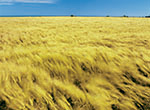Tank up with ethanol
Henry Ford’s Model T in 1908 used it. Only in the 1940s, when gasoline prices fell so low that ethanol was no longer economical, did ethanol largely disappear.
DATE 2023-11-28 AUTHOR Michael LawtonThe oil-price shock of the 1970's sparked new interest in ethanol, which can be made from any agricultural crop containing sugar, starch or even cellulose. It could be used instead of gasoline to reduce a country’s dependence on imported fuel. Brazil took it up in a big way; nowadays ethanol meets about half its vehicle-fuel needs. In the United States, use has been steadily increasing; ethanol represented about 1.5 percent of fuel use in 2001. Proposed changes in the law may now give it a boost. Europe also is likely to establish a legal and fiscal framework that will encourage the use of ethanol.
Christoph Berg, senior commodity analyst with F.O.Licht, says the ethanol world needs a proper trading system with a futures market. "You need supply security,” he says. “Ethanol is dependent on crops, and shortfalls have to be filled."
U.S. to develop ethanol
Currently the U.S. is the motor for the industry; the Senate recently passed a bill that would increase ethanol use from 1.5 billion to 5 billion gallons (6.8 to 22.7 billion litres) a year by 2012.Mike Bryant, of renewable fuel consultants BBI International in Cotopaxi, Colorado, gives three main reasons for the U.S. to develop ethanol production. In addition to reducing dependency on foreign oil, ethanol has environmental advantages and is an economic driver for the rural economy.
Environmentally, a real boost for ethanol came with the Clean Air Act amendments in 1990, which mandated the use of oxygenates in fuel in areas suffering from high carbon monoxide levels. Oxygenates, such as ethanol, add oxygen to fuel so that they burn more completely. A 10 percent ethanol mixture, known as E 10, can be used without adaptation in any modern gasoline engine. U.S. manufacturers also make "flex-fuel" vehicles, which can run on anything from pure gasoline to an 85 percent ethanol blend.
Renewable fuel
 Like all fuels, ethanol gives off carbon dioxide, thus increasing global warming, but the crops used to make ethanol bind carbon dioxide from the atmosphere as they grow. In an ideal world, the crop would use up all the carbon dioxide produced by the fuel, but environmentalists such as Dan Lashoff, senior scientist with the Natural Resources Defense Council, say that ethanol made from corn only gives a 25 percent improvement in carbon dioxide levels over gasoline, because growing corn requires large amounts of oil-based fertilizer.
Like all fuels, ethanol gives off carbon dioxide, thus increasing global warming, but the crops used to make ethanol bind carbon dioxide from the atmosphere as they grow. In an ideal world, the crop would use up all the carbon dioxide produced by the fuel, but environmentalists such as Dan Lashoff, senior scientist with the Natural Resources Defense Council, say that ethanol made from corn only gives a 25 percent improvement in carbon dioxide levels over gasoline, because growing corn requires large amounts of oil-based fertilizer.
Lashoff wants to see ethanol produced from agricultural waste products such as rice stalks. "That way you can get an 80 to 90 percent reduction in carbon dioxide," he says.
Worldwide interest
In Europe, legal requirements have been delaying ethanol development. In Germany, tax breaks are only available on pure renewable fuels, such as rapeseed-oil diesel, and not on the renewable content of blended fuels, such as ethanol/gasoline mixtures. That will change, and the European Union has drafted a directive allowing a halving of excise taxes on renewable fuels and mandating a market share of 5.75 percent by 2010.
Canada, South Africa and Australia all have programs to increase ethanol production, but perhaps Asia is the most interesting future market. India has committed itself to a 5 percent ethanol mixture for all gasoline vehicles. And China is currently building the world’s biggest ethanol plant in Jilin province, to produce 800,000 tonnes a year.
How to make ethanol
Fermenting sugar produces ethanol, and sugar can be hydrolysed from starch. Sugar cane, corn and other grains are often used as feedstock. Sugar can also be produced from cellulose, but the process is complex and expensive.
Alfa Laval is involved all the way along the ethanol production chain. In a typical corn dry-milling process, as used in the majority of U.S. plants, Alfa Laval supplies heat exchangers to heat and cool the cornmeal/enzyme mixture as it is turned into sugar. Apart from coolers and heaters, Alfa Laval has also developed thermal equipment tailored for two-phase duties such as reboilers, condensers and evaporators.
Reboilers and condensers are needed at either end of the distillation columns, and decanters and evaporators are used to make the stillage into an animal feed – distillers’ dried grains – which are the main by-product. Alfa Laval also makes separators to recycle the yeast, which would otherwise be wasted.
As Walter Luis Polonia, engineering supervisor at the Usina de Barra in Brazil, says, "We’ve been doing business with Alfa Laval ever since the distillery was built in 1945. Alfa Laval, like no other supplier, has the combination of tools, expertise and a broad range of key equipment to improve the performance of our process."

